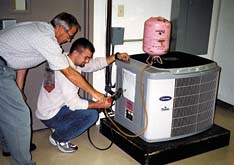According to Feathers, the department has 114 students. This October, the program will be getting 54 incoming students to begin the program. Feathers credits this kind of success with the large market of heating and cooling companies in and around Centerville. He says that the majority of his students are non-traditional, with an average age of about 30. Many of Feather’s students are older workers looking to retrain and take advantage of the local HVAC industry.
Feathers also says that RETS Tech is one of the only post-secondary schools in the area offering an HVACR program. With this in mind, Feathers wants his program to not only be the best, but also have the validation from the industry to prove it. That is why Feathers and the program decided to work towards the Partnership for Air-Conditioning, Heating, and Refrigeration Accreditation (PAHRA). PAHRA has taken the already successful RETS Tech program and made it into something even better.

GETTING ON THE SAME PAGE
Feathers learned about PAHRA about three years ago through his involvement with the Council of Air-Conditioning and Refrigeration Educators (CARE) and the Air-Conditioning and Refrigeration Institute’s (ARI’s) Instructor Workshops.The instructor explains that his school was encouraging all programs to seek some kind of accreditation. When Feathers heard about PAHRA, he says that many instructors were very enthusiastic about it. He then decided to begin the PAHRA process, which took the department close to a year to complete.
“It was really a great chore,” Feathers said about the process. “But we have a really great staff that helped us out.”
The most challenging part of earning the accreditation, according to Feathers, was compiling all of the necessary information.
“There were so many aspects we needed to cover, from administration to financial aid to the class itself and our placement rates,” explains Feathers.
But even this was not too much of a challenge because Feathers says his administration was more than willing to help him and the department obtain the accreditation.
RETS Tech finally earned the accreditation back in June when the school had a site visit from the PAHRA committee.
The accreditation has been beneficial to RETS Tech in many ways. For example, Feathers says that his program is receiving more attention. Manufacturers are now contacting the program and asking if they need help with donations.
Some benefits are not so concrete, but important all the same. Feathers says that PAHRA is beneficial to the industry as a whole.
“This gets everyone on the same page,” Feathers said about the accreditation. “I think there is a need in our industry for standards. It is essential. When I went to school, it didn’t seem like things were standardized.”
Feathers explains that many HVACR programs are in danger of shutting down. But the instructor believes that PAHRA “could save a lot of programs.” He says that by earning PAHRA, a program proves that it is teaching what a technician needs to know before entering the field.
SPREADING THE NEWS
Feathers believes that PAHRA is the key to strengthening and saving many programs that are beginning to falter. The instructor is the president of the Ohio chapter of CARE (OCARE). The chapter is making it a point to get through to other HVACR programs in the state about the benefits of PAHRA.He also says that there has been some talk that the state department of education may make accreditation mandatory for many educational programs. If that is the case, Feathers says that he and OCARE want to reach as many programs as possible so that they can get started with the PAHRA process.
“PAHRA is really the cream of the crop,” said Feathers. “It is supported by the entire industry.”
Publication date: 09/30/2002


Report Abusive Comment